Microbe and Immunology Assignment PDF
VerifiedAdded on 2022/07/28
|10
|1854
|15
AI Summary
Please answer the questions in this file
Contribute Materials
Your contribution can guide someone’s learning journey. Share your
documents today.
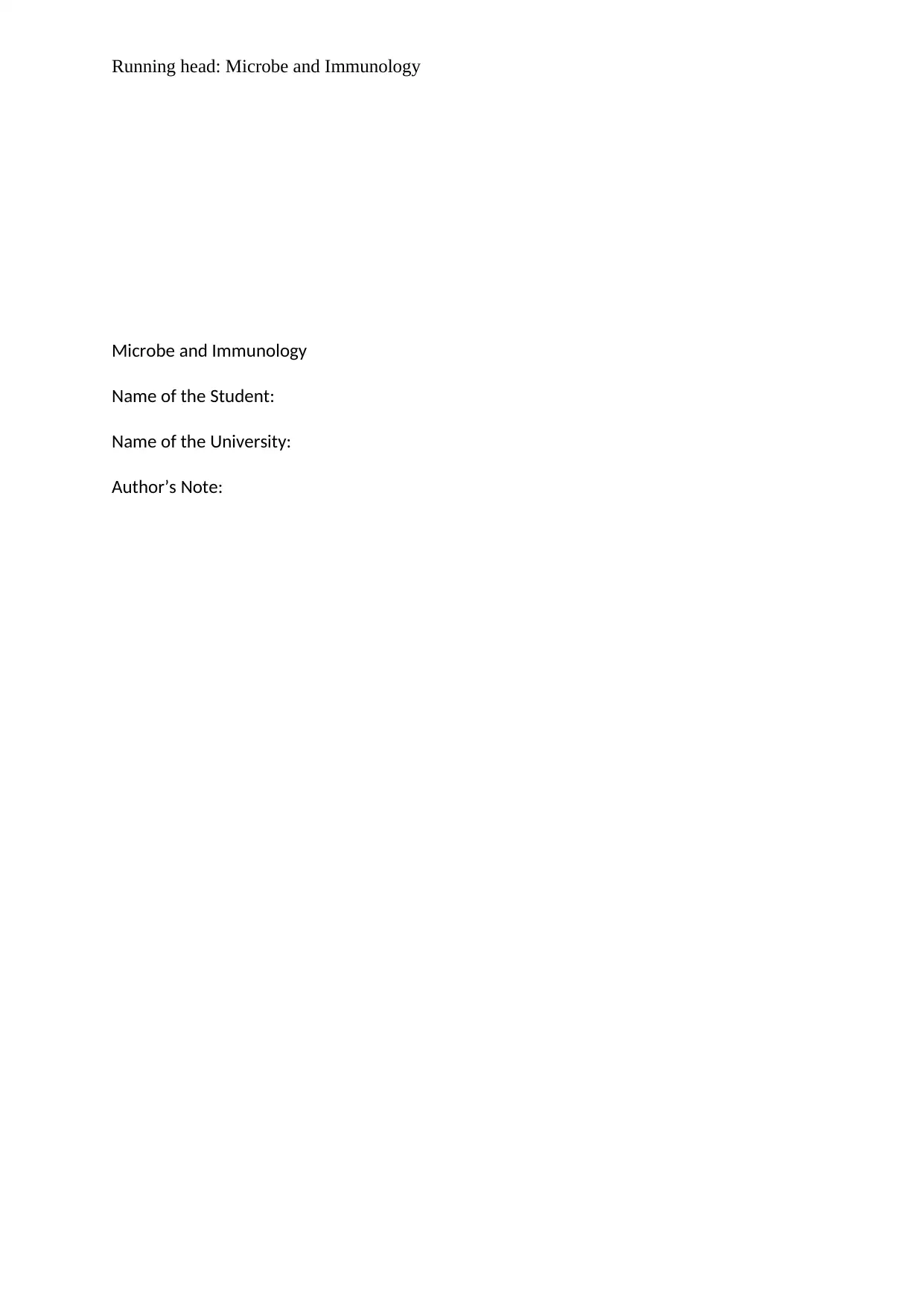
Running head: Microbe and Immunology
Microbe and Immunology
Name of the Student:
Name of the University:
Author’s Note:
Microbe and Immunology
Name of the Student:
Name of the University:
Author’s Note:
Secure Best Marks with AI Grader
Need help grading? Try our AI Grader for instant feedback on your assignments.
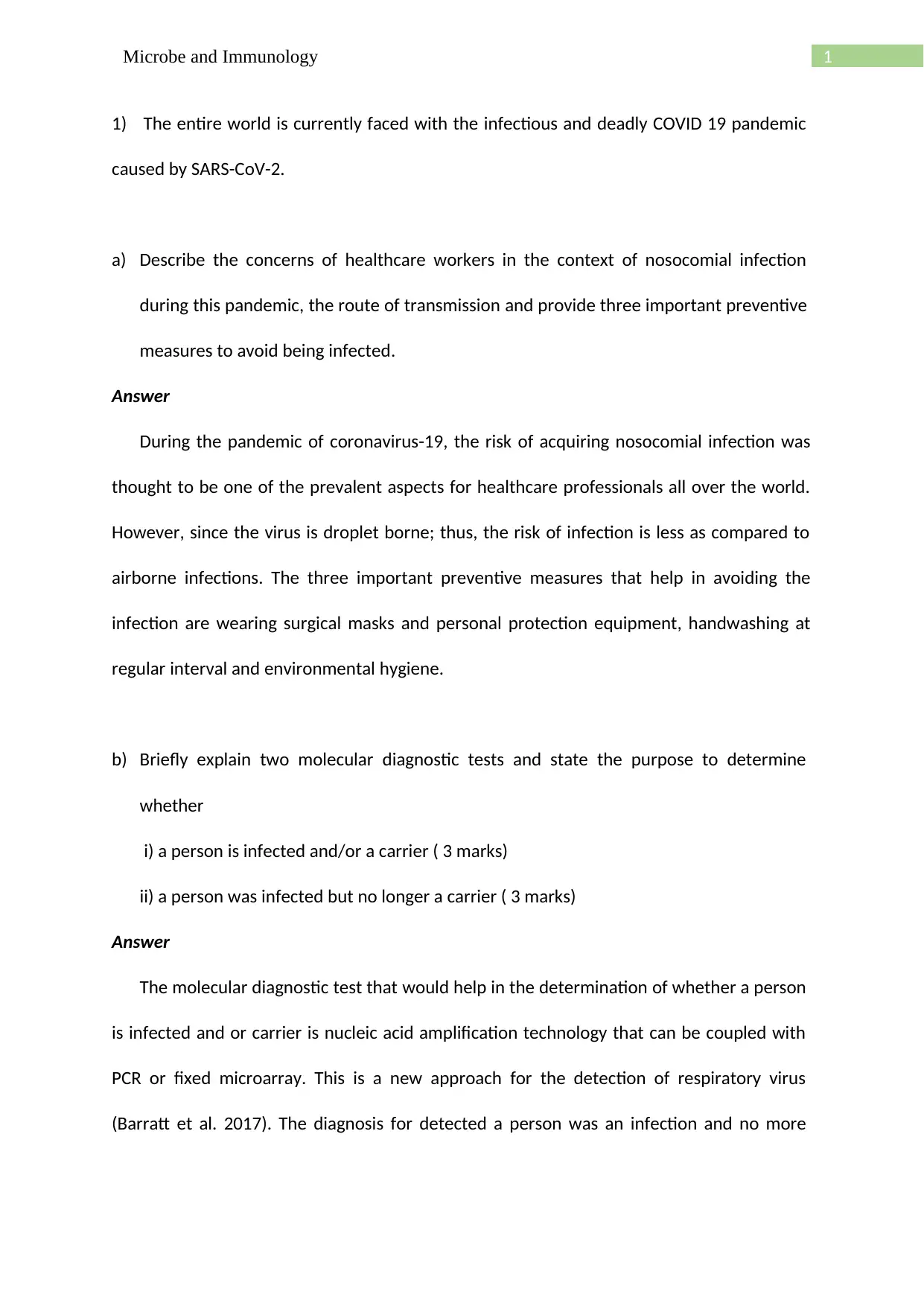
1Microbe and Immunology
1) The entire world is currently faced with the infectious and deadly COVID 19 pandemic
caused by SARS-CoV-2.
a) Describe the concerns of healthcare workers in the context of nosocomial infection
during this pandemic, the route of transmission and provide three important preventive
measures to avoid being infected.
Answer
During the pandemic of coronavirus-19, the risk of acquiring nosocomial infection was
thought to be one of the prevalent aspects for healthcare professionals all over the world.
However, since the virus is droplet borne; thus, the risk of infection is less as compared to
airborne infections. The three important preventive measures that help in avoiding the
infection are wearing surgical masks and personal protection equipment, handwashing at
regular interval and environmental hygiene.
b) Briefly explain two molecular diagnostic tests and state the purpose to determine
whether
i) a person is infected and/or a carrier ( 3 marks)
ii) a person was infected but no longer a carrier ( 3 marks)
Answer
The molecular diagnostic test that would help in the determination of whether a person
is infected and or carrier is nucleic acid amplification technology that can be coupled with
PCR or fixed microarray. This is a new approach for the detection of respiratory virus
(Barratt et al. 2017). The diagnosis for detected a person was an infection and no more
1) The entire world is currently faced with the infectious and deadly COVID 19 pandemic
caused by SARS-CoV-2.
a) Describe the concerns of healthcare workers in the context of nosocomial infection
during this pandemic, the route of transmission and provide three important preventive
measures to avoid being infected.
Answer
During the pandemic of coronavirus-19, the risk of acquiring nosocomial infection was
thought to be one of the prevalent aspects for healthcare professionals all over the world.
However, since the virus is droplet borne; thus, the risk of infection is less as compared to
airborne infections. The three important preventive measures that help in avoiding the
infection are wearing surgical masks and personal protection equipment, handwashing at
regular interval and environmental hygiene.
b) Briefly explain two molecular diagnostic tests and state the purpose to determine
whether
i) a person is infected and/or a carrier ( 3 marks)
ii) a person was infected but no longer a carrier ( 3 marks)
Answer
The molecular diagnostic test that would help in the determination of whether a person
is infected and or carrier is nucleic acid amplification technology that can be coupled with
PCR or fixed microarray. This is a new approach for the detection of respiratory virus
(Barratt et al. 2017). The diagnosis for detected a person was an infection and no more
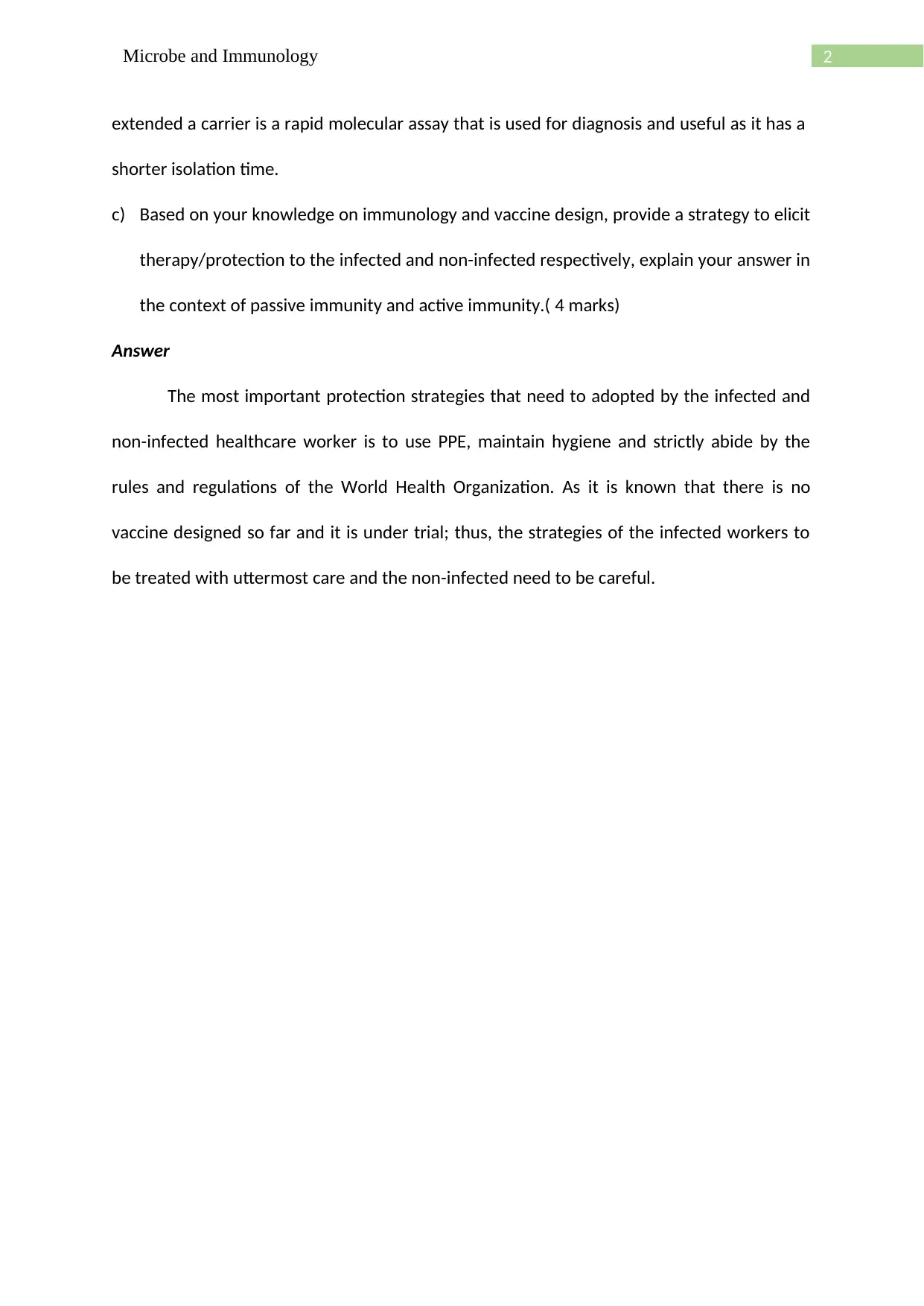
2Microbe and Immunology
extended a carrier is a rapid molecular assay that is used for diagnosis and useful as it has a
shorter isolation time.
c) Based on your knowledge on immunology and vaccine design, provide a strategy to elicit
therapy/protection to the infected and non-infected respectively, explain your answer in
the context of passive immunity and active immunity.( 4 marks)
Answer
The most important protection strategies that need to adopted by the infected and
non-infected healthcare worker is to use PPE, maintain hygiene and strictly abide by the
rules and regulations of the World Health Organization. As it is known that there is no
vaccine designed so far and it is under trial; thus, the strategies of the infected workers to
be treated with uttermost care and the non-infected need to be careful.
extended a carrier is a rapid molecular assay that is used for diagnosis and useful as it has a
shorter isolation time.
c) Based on your knowledge on immunology and vaccine design, provide a strategy to elicit
therapy/protection to the infected and non-infected respectively, explain your answer in
the context of passive immunity and active immunity.( 4 marks)
Answer
The most important protection strategies that need to adopted by the infected and
non-infected healthcare worker is to use PPE, maintain hygiene and strictly abide by the
rules and regulations of the World Health Organization. As it is known that there is no
vaccine designed so far and it is under trial; thus, the strategies of the infected workers to
be treated with uttermost care and the non-infected need to be careful.
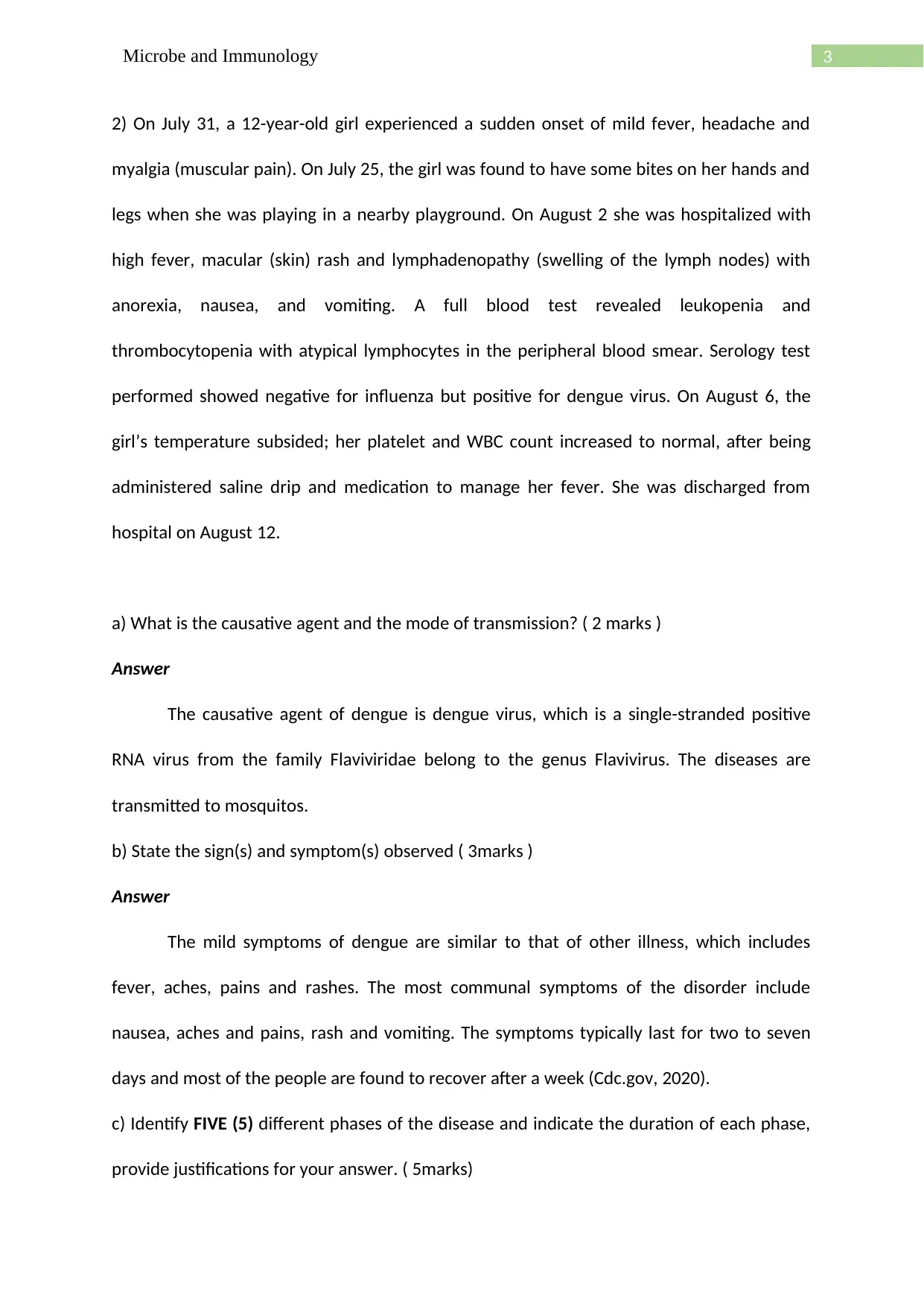
3Microbe and Immunology
2) On July 31, a 12-year-old girl experienced a sudden onset of mild fever, headache and
myalgia (muscular pain). On July 25, the girl was found to have some bites on her hands and
legs when she was playing in a nearby playground. On August 2 she was hospitalized with
high fever, macular (skin) rash and lymphadenopathy (swelling of the lymph nodes) with
anorexia, nausea, and vomiting. A full blood test revealed leukopenia and
thrombocytopenia with atypical lymphocytes in the peripheral blood smear. Serology test
performed showed negative for influenza but positive for dengue virus. On August 6, the
girl’s temperature subsided; her platelet and WBC count increased to normal, after being
administered saline drip and medication to manage her fever. She was discharged from
hospital on August 12.
a) What is the causative agent and the mode of transmission? ( 2 marks )
Answer
The causative agent of dengue is dengue virus, which is a single-stranded positive
RNA virus from the family Flaviviridae belong to the genus Flavivirus. The diseases are
transmitted to mosquitos.
b) State the sign(s) and symptom(s) observed ( 3marks )
Answer
The mild symptoms of dengue are similar to that of other illness, which includes
fever, aches, pains and rashes. The most communal symptoms of the disorder include
nausea, aches and pains, rash and vomiting. The symptoms typically last for two to seven
days and most of the people are found to recover after a week (Cdc.gov, 2020).
c) Identify FIVE (5) different phases of the disease and indicate the duration of each phase,
provide justifications for your answer. ( 5marks)
2) On July 31, a 12-year-old girl experienced a sudden onset of mild fever, headache and
myalgia (muscular pain). On July 25, the girl was found to have some bites on her hands and
legs when she was playing in a nearby playground. On August 2 she was hospitalized with
high fever, macular (skin) rash and lymphadenopathy (swelling of the lymph nodes) with
anorexia, nausea, and vomiting. A full blood test revealed leukopenia and
thrombocytopenia with atypical lymphocytes in the peripheral blood smear. Serology test
performed showed negative for influenza but positive for dengue virus. On August 6, the
girl’s temperature subsided; her platelet and WBC count increased to normal, after being
administered saline drip and medication to manage her fever. She was discharged from
hospital on August 12.
a) What is the causative agent and the mode of transmission? ( 2 marks )
Answer
The causative agent of dengue is dengue virus, which is a single-stranded positive
RNA virus from the family Flaviviridae belong to the genus Flavivirus. The diseases are
transmitted to mosquitos.
b) State the sign(s) and symptom(s) observed ( 3marks )
Answer
The mild symptoms of dengue are similar to that of other illness, which includes
fever, aches, pains and rashes. The most communal symptoms of the disorder include
nausea, aches and pains, rash and vomiting. The symptoms typically last for two to seven
days and most of the people are found to recover after a week (Cdc.gov, 2020).
c) Identify FIVE (5) different phases of the disease and indicate the duration of each phase,
provide justifications for your answer. ( 5marks)
Secure Best Marks with AI Grader
Need help grading? Try our AI Grader for instant feedback on your assignments.
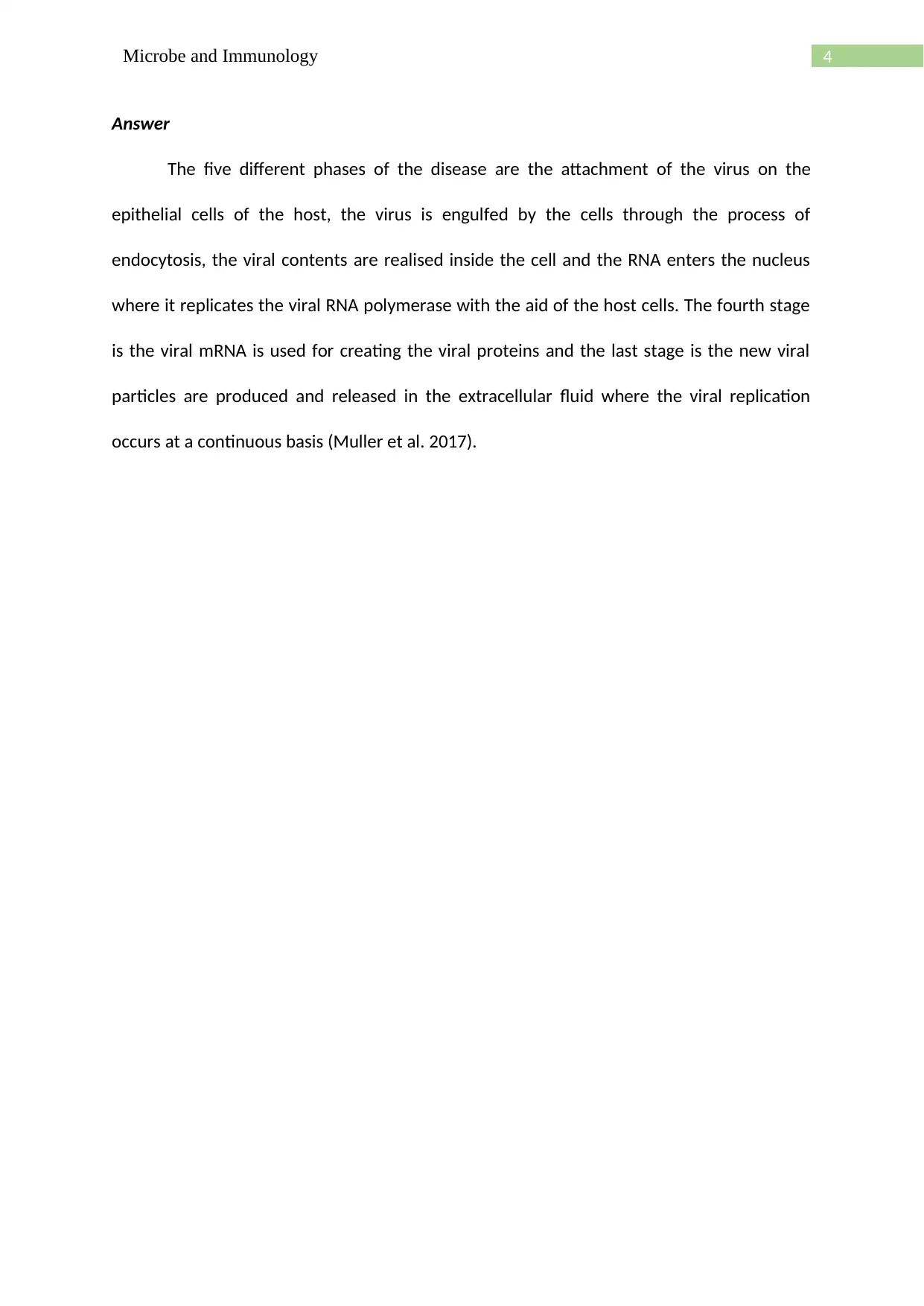
4Microbe and Immunology
Answer
The five different phases of the disease are the attachment of the virus on the
epithelial cells of the host, the virus is engulfed by the cells through the process of
endocytosis, the viral contents are realised inside the cell and the RNA enters the nucleus
where it replicates the viral RNA polymerase with the aid of the host cells. The fourth stage
is the viral mRNA is used for creating the viral proteins and the last stage is the new viral
particles are produced and released in the extracellular fluid where the viral replication
occurs at a continuous basis (Muller et al. 2017).
Answer
The five different phases of the disease are the attachment of the virus on the
epithelial cells of the host, the virus is engulfed by the cells through the process of
endocytosis, the viral contents are realised inside the cell and the RNA enters the nucleus
where it replicates the viral RNA polymerase with the aid of the host cells. The fourth stage
is the viral mRNA is used for creating the viral proteins and the last stage is the new viral
particles are produced and released in the extracellular fluid where the viral replication
occurs at a continuous basis (Muller et al. 2017).
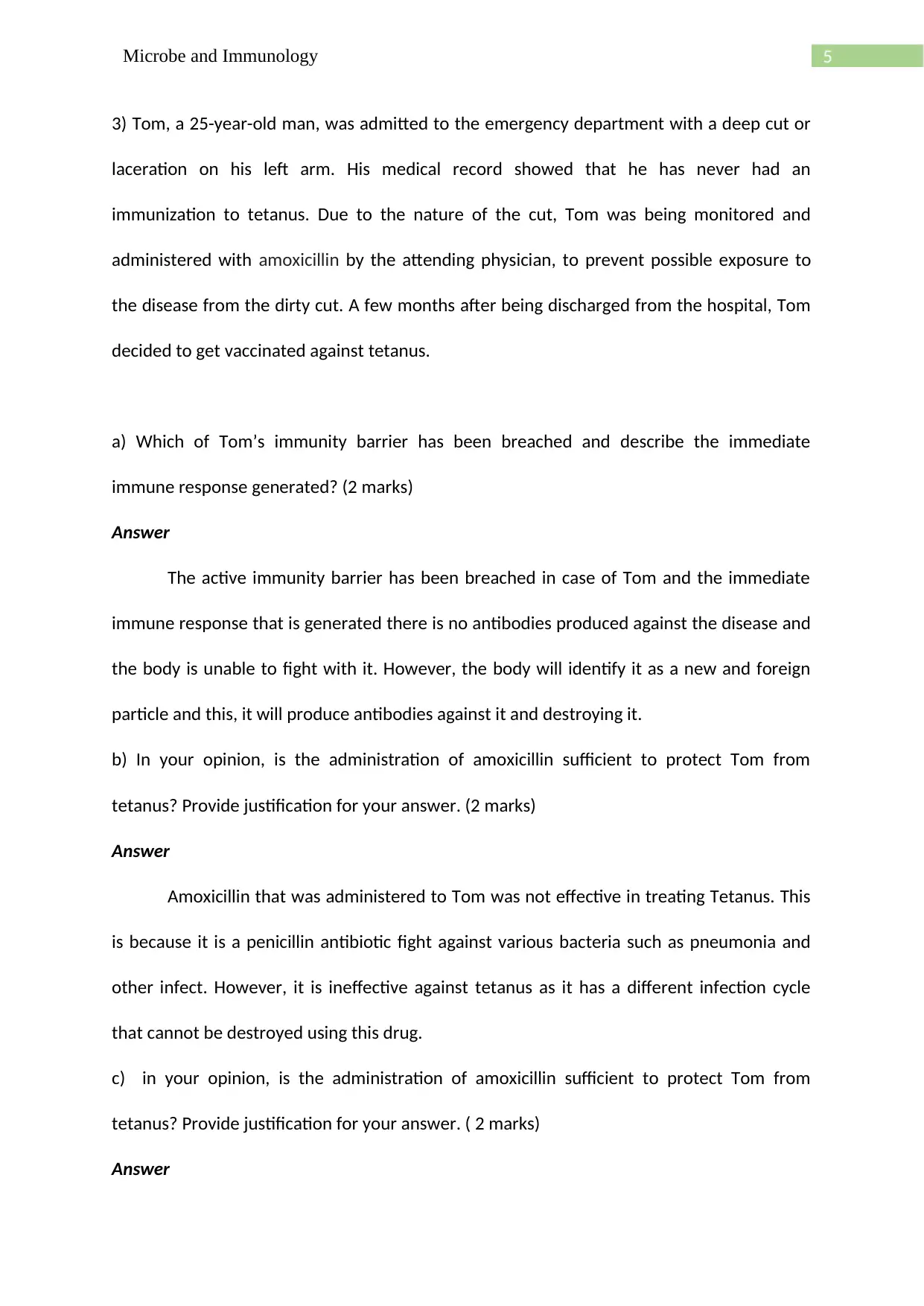
5Microbe and Immunology
3) Tom, a 25-year-old man, was admitted to the emergency department with a deep cut or
laceration on his left arm. His medical record showed that he has never had an
immunization to tetanus. Due to the nature of the cut, Tom was being monitored and
administered with amoxicillin by the attending physician, to prevent possible exposure to
the disease from the dirty cut. A few months after being discharged from the hospital, Tom
decided to get vaccinated against tetanus.
a) Which of Tom’s immunity barrier has been breached and describe the immediate
immune response generated? (2 marks)
Answer
The active immunity barrier has been breached in case of Tom and the immediate
immune response that is generated there is no antibodies produced against the disease and
the body is unable to fight with it. However, the body will identify it as a new and foreign
particle and this, it will produce antibodies against it and destroying it.
b) In your opinion, is the administration of amoxicillin sufficient to protect Tom from
tetanus? Provide justification for your answer. (2 marks)
Answer
Amoxicillin that was administered to Tom was not effective in treating Tetanus. This
is because it is a penicillin antibiotic fight against various bacteria such as pneumonia and
other infect. However, it is ineffective against tetanus as it has a different infection cycle
that cannot be destroyed using this drug.
c) in your opinion, is the administration of amoxicillin sufficient to protect Tom from
tetanus? Provide justification for your answer. ( 2 marks)
Answer
3) Tom, a 25-year-old man, was admitted to the emergency department with a deep cut or
laceration on his left arm. His medical record showed that he has never had an
immunization to tetanus. Due to the nature of the cut, Tom was being monitored and
administered with amoxicillin by the attending physician, to prevent possible exposure to
the disease from the dirty cut. A few months after being discharged from the hospital, Tom
decided to get vaccinated against tetanus.
a) Which of Tom’s immunity barrier has been breached and describe the immediate
immune response generated? (2 marks)
Answer
The active immunity barrier has been breached in case of Tom and the immediate
immune response that is generated there is no antibodies produced against the disease and
the body is unable to fight with it. However, the body will identify it as a new and foreign
particle and this, it will produce antibodies against it and destroying it.
b) In your opinion, is the administration of amoxicillin sufficient to protect Tom from
tetanus? Provide justification for your answer. (2 marks)
Answer
Amoxicillin that was administered to Tom was not effective in treating Tetanus. This
is because it is a penicillin antibiotic fight against various bacteria such as pneumonia and
other infect. However, it is ineffective against tetanus as it has a different infection cycle
that cannot be destroyed using this drug.
c) in your opinion, is the administration of amoxicillin sufficient to protect Tom from
tetanus? Provide justification for your answer. ( 2 marks)
Answer
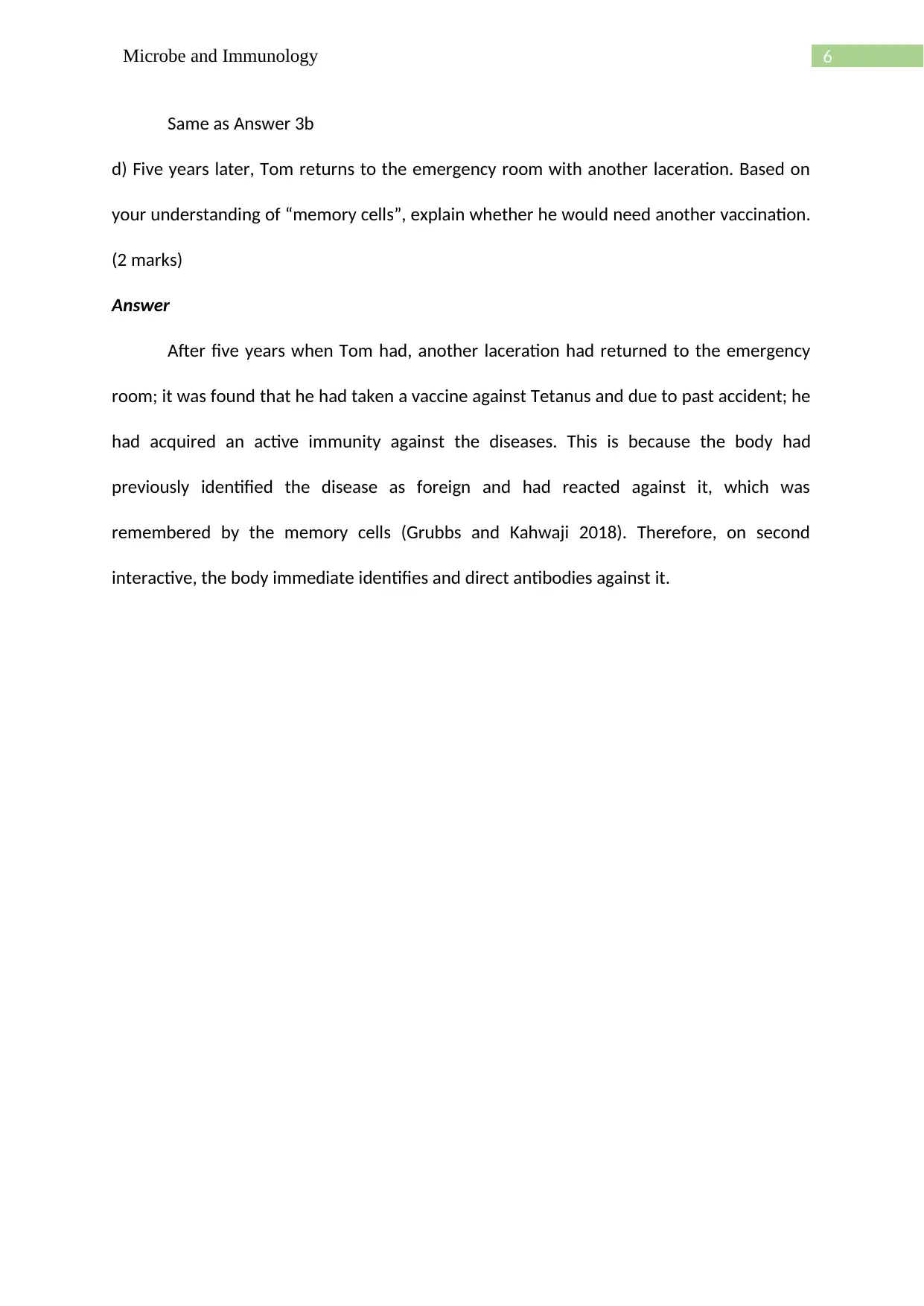
6Microbe and Immunology
Same as Answer 3b
d) Five years later, Tom returns to the emergency room with another laceration. Based on
your understanding of “memory cells”, explain whether he would need another vaccination.
(2 marks)
Answer
After five years when Tom had, another laceration had returned to the emergency
room; it was found that he had taken a vaccine against Tetanus and due to past accident; he
had acquired an active immunity against the diseases. This is because the body had
previously identified the disease as foreign and had reacted against it, which was
remembered by the memory cells (Grubbs and Kahwaji 2018). Therefore, on second
interactive, the body immediate identifies and direct antibodies against it.
Same as Answer 3b
d) Five years later, Tom returns to the emergency room with another laceration. Based on
your understanding of “memory cells”, explain whether he would need another vaccination.
(2 marks)
Answer
After five years when Tom had, another laceration had returned to the emergency
room; it was found that he had taken a vaccine against Tetanus and due to past accident; he
had acquired an active immunity against the diseases. This is because the body had
previously identified the disease as foreign and had reacted against it, which was
remembered by the memory cells (Grubbs and Kahwaji 2018). Therefore, on second
interactive, the body immediate identifies and direct antibodies against it.
Paraphrase This Document
Need a fresh take? Get an instant paraphrase of this document with our AI Paraphraser
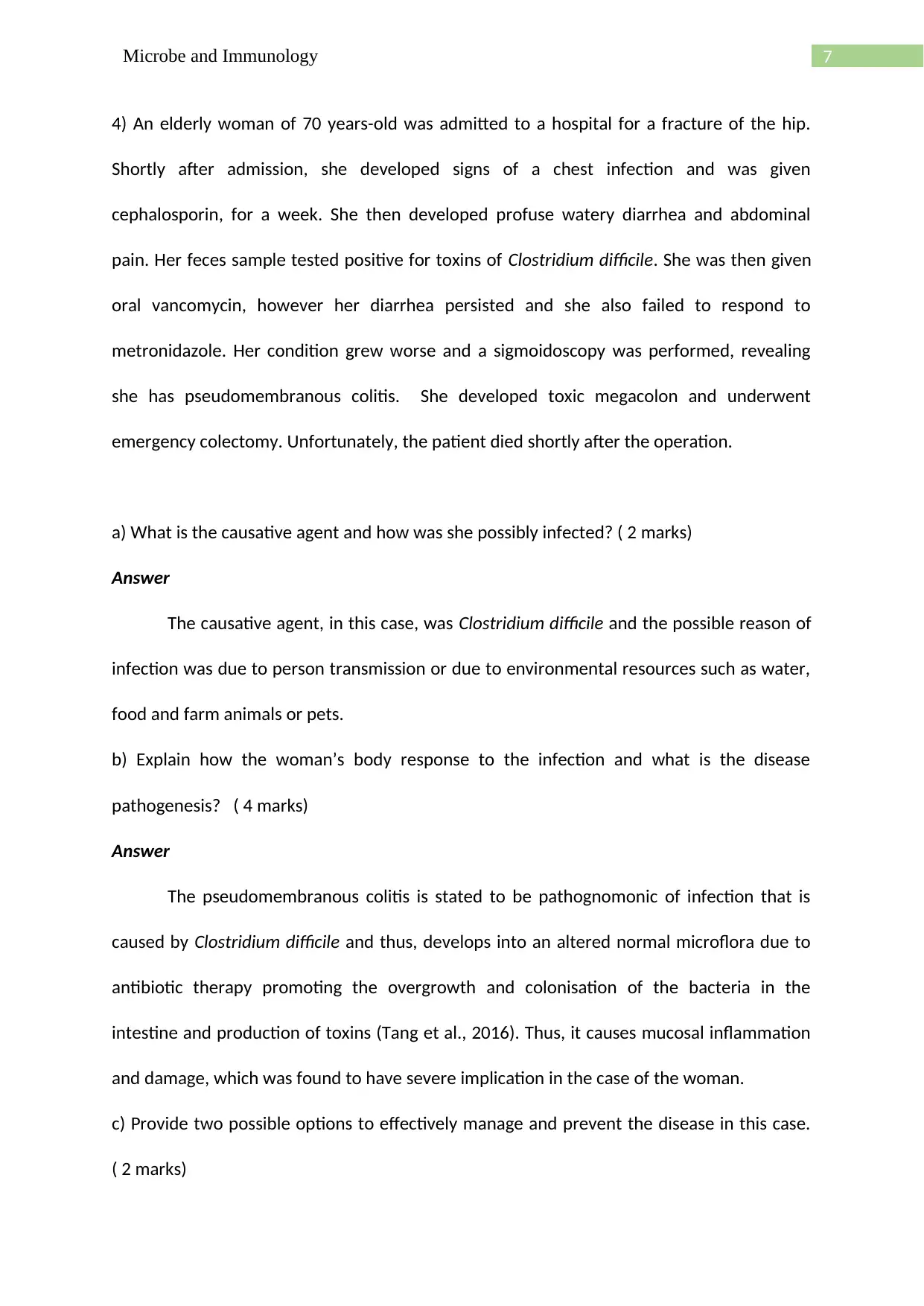
7Microbe and Immunology
4) An elderly woman of 70 years-old was admitted to a hospital for a fracture of the hip.
Shortly after admission, she developed signs of a chest infection and was given
cephalosporin, for a week. She then developed profuse watery diarrhea and abdominal
pain. Her feces sample tested positive for toxins of Clostridium difficile. She was then given
oral vancomycin, however her diarrhea persisted and she also failed to respond to
metronidazole. Her condition grew worse and a sigmoidoscopy was performed, revealing
she has pseudomembranous colitis. She developed toxic megacolon and underwent
emergency colectomy. Unfortunately, the patient died shortly after the operation.
a) What is the causative agent and how was she possibly infected? ( 2 marks)
Answer
The causative agent, in this case, was Clostridium difficile and the possible reason of
infection was due to person transmission or due to environmental resources such as water,
food and farm animals or pets.
b) Explain how the woman’s body response to the infection and what is the disease
pathogenesis? ( 4 marks)
Answer
The pseudomembranous colitis is stated to be pathognomonic of infection that is
caused by Clostridium difficile and thus, develops into an altered normal microflora due to
antibiotic therapy promoting the overgrowth and colonisation of the bacteria in the
intestine and production of toxins (Tang et al., 2016). Thus, it causes mucosal inflammation
and damage, which was found to have severe implication in the case of the woman.
c) Provide two possible options to effectively manage and prevent the disease in this case.
( 2 marks)
4) An elderly woman of 70 years-old was admitted to a hospital for a fracture of the hip.
Shortly after admission, she developed signs of a chest infection and was given
cephalosporin, for a week. She then developed profuse watery diarrhea and abdominal
pain. Her feces sample tested positive for toxins of Clostridium difficile. She was then given
oral vancomycin, however her diarrhea persisted and she also failed to respond to
metronidazole. Her condition grew worse and a sigmoidoscopy was performed, revealing
she has pseudomembranous colitis. She developed toxic megacolon and underwent
emergency colectomy. Unfortunately, the patient died shortly after the operation.
a) What is the causative agent and how was she possibly infected? ( 2 marks)
Answer
The causative agent, in this case, was Clostridium difficile and the possible reason of
infection was due to person transmission or due to environmental resources such as water,
food and farm animals or pets.
b) Explain how the woman’s body response to the infection and what is the disease
pathogenesis? ( 4 marks)
Answer
The pseudomembranous colitis is stated to be pathognomonic of infection that is
caused by Clostridium difficile and thus, develops into an altered normal microflora due to
antibiotic therapy promoting the overgrowth and colonisation of the bacteria in the
intestine and production of toxins (Tang et al., 2016). Thus, it causes mucosal inflammation
and damage, which was found to have severe implication in the case of the woman.
c) Provide two possible options to effectively manage and prevent the disease in this case.
( 2 marks)
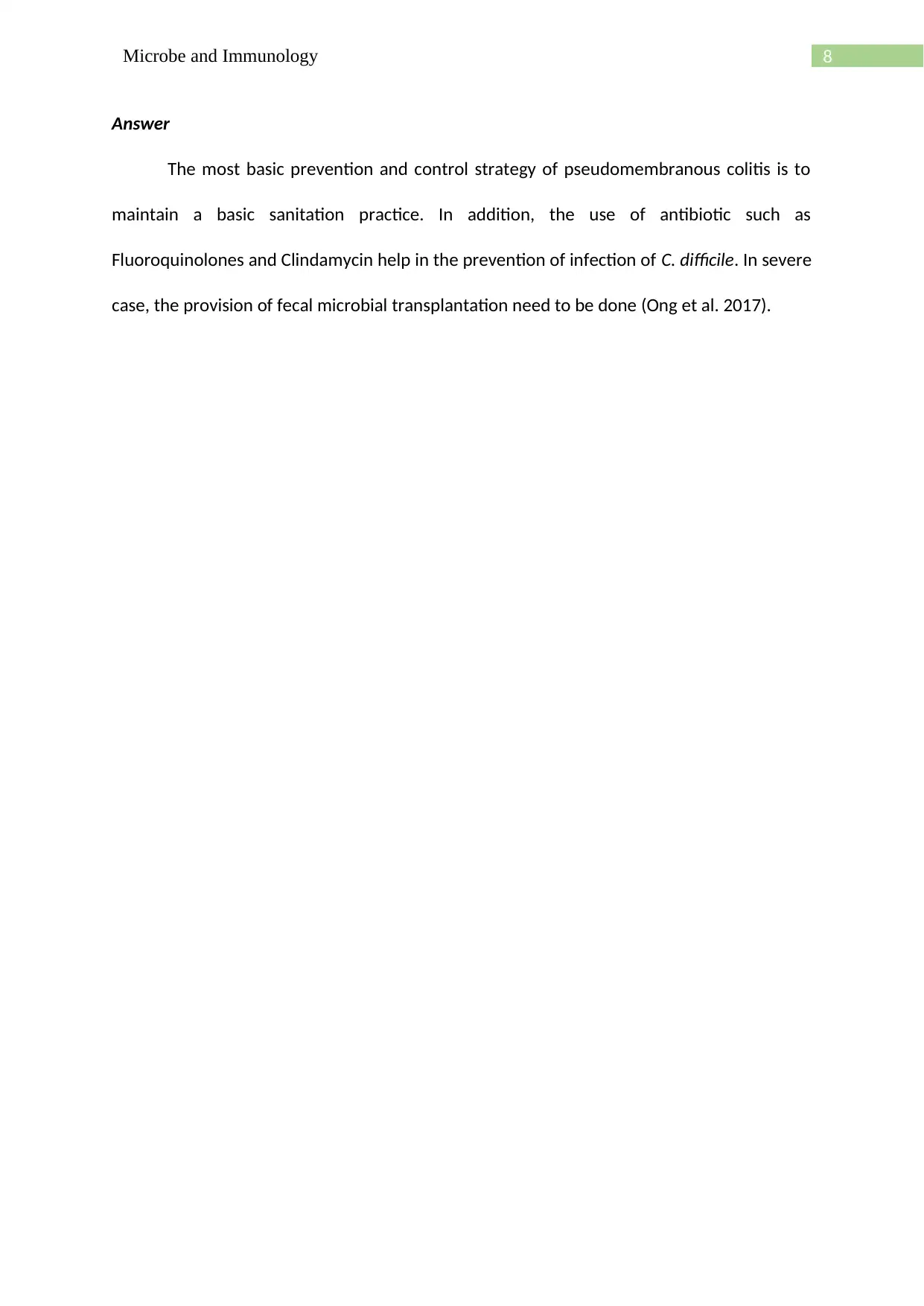
8Microbe and Immunology
Answer
The most basic prevention and control strategy of pseudomembranous colitis is to
maintain a basic sanitation practice. In addition, the use of antibiotic such as
Fluoroquinolones and Clindamycin help in the prevention of infection of C. difficile. In severe
case, the provision of fecal microbial transplantation need to be done (Ong et al. 2017).
Answer
The most basic prevention and control strategy of pseudomembranous colitis is to
maintain a basic sanitation practice. In addition, the use of antibiotic such as
Fluoroquinolones and Clindamycin help in the prevention of infection of C. difficile. In severe
case, the provision of fecal microbial transplantation need to be done (Ong et al. 2017).
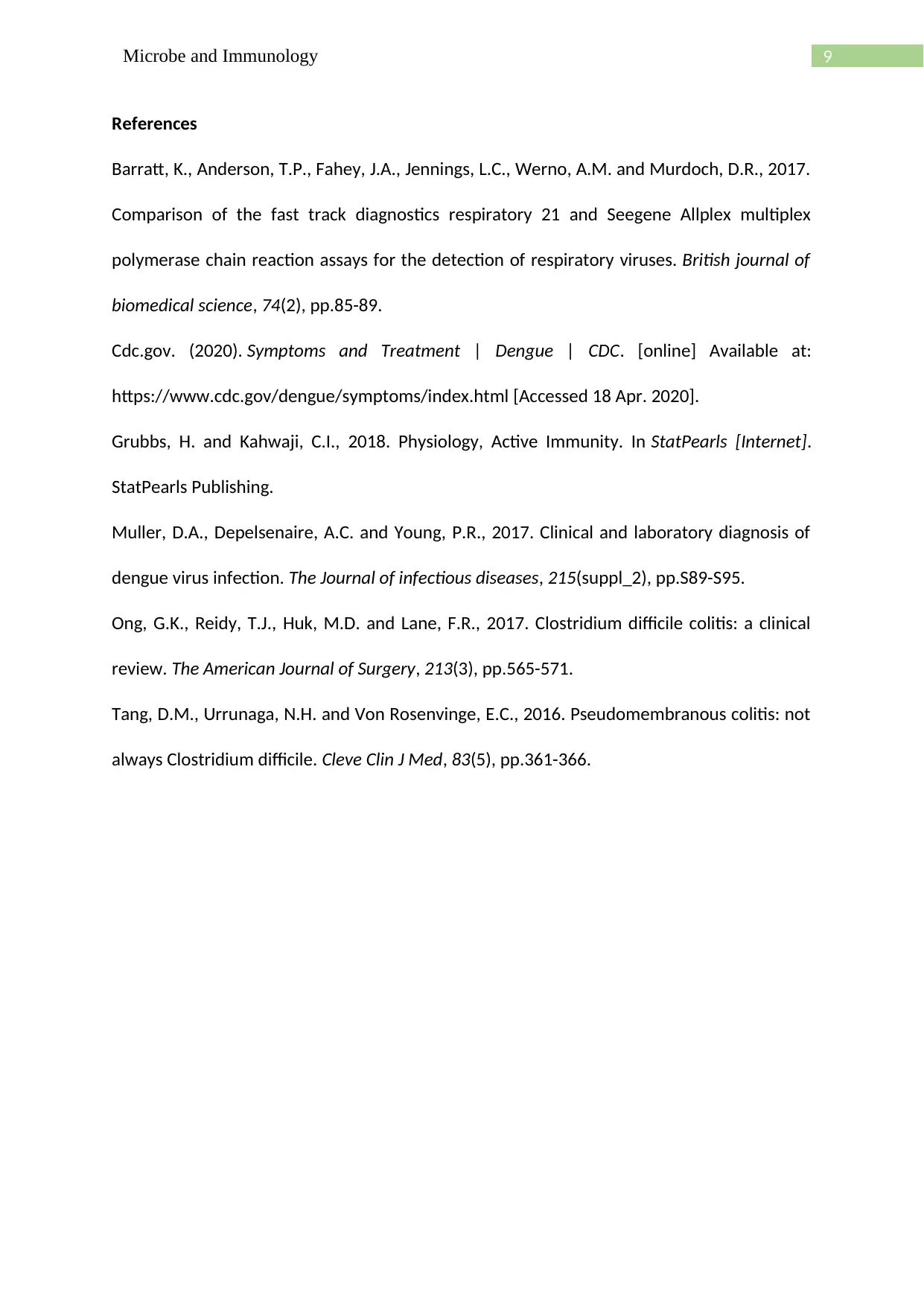
9Microbe and Immunology
References
Barratt, K., Anderson, T.P., Fahey, J.A., Jennings, L.C., Werno, A.M. and Murdoch, D.R., 2017.
Comparison of the fast track diagnostics respiratory 21 and Seegene Allplex multiplex
polymerase chain reaction assays for the detection of respiratory viruses. British journal of
biomedical science, 74(2), pp.85-89.
Cdc.gov. (2020). Symptoms and Treatment | Dengue | CDC. [online] Available at:
https://www.cdc.gov/dengue/symptoms/index.html [Accessed 18 Apr. 2020].
Grubbs, H. and Kahwaji, C.I., 2018. Physiology, Active Immunity. In StatPearls [Internet].
StatPearls Publishing.
Muller, D.A., Depelsenaire, A.C. and Young, P.R., 2017. Clinical and laboratory diagnosis of
dengue virus infection. The Journal of infectious diseases, 215(suppl_2), pp.S89-S95.
Ong, G.K., Reidy, T.J., Huk, M.D. and Lane, F.R., 2017. Clostridium difficile colitis: a clinical
review. The American Journal of Surgery, 213(3), pp.565-571.
Tang, D.M., Urrunaga, N.H. and Von Rosenvinge, E.C., 2016. Pseudomembranous colitis: not
always Clostridium difficile. Cleve Clin J Med, 83(5), pp.361-366.
References
Barratt, K., Anderson, T.P., Fahey, J.A., Jennings, L.C., Werno, A.M. and Murdoch, D.R., 2017.
Comparison of the fast track diagnostics respiratory 21 and Seegene Allplex multiplex
polymerase chain reaction assays for the detection of respiratory viruses. British journal of
biomedical science, 74(2), pp.85-89.
Cdc.gov. (2020). Symptoms and Treatment | Dengue | CDC. [online] Available at:
https://www.cdc.gov/dengue/symptoms/index.html [Accessed 18 Apr. 2020].
Grubbs, H. and Kahwaji, C.I., 2018. Physiology, Active Immunity. In StatPearls [Internet].
StatPearls Publishing.
Muller, D.A., Depelsenaire, A.C. and Young, P.R., 2017. Clinical and laboratory diagnosis of
dengue virus infection. The Journal of infectious diseases, 215(suppl_2), pp.S89-S95.
Ong, G.K., Reidy, T.J., Huk, M.D. and Lane, F.R., 2017. Clostridium difficile colitis: a clinical
review. The American Journal of Surgery, 213(3), pp.565-571.
Tang, D.M., Urrunaga, N.H. and Von Rosenvinge, E.C., 2016. Pseudomembranous colitis: not
always Clostridium difficile. Cleve Clin J Med, 83(5), pp.361-366.
1 out of 10
Related Documents
Your All-in-One AI-Powered Toolkit for Academic Success.
+13062052269
info@desklib.com
Available 24*7 on WhatsApp / Email
![[object Object]](/_next/static/media/star-bottom.7253800d.svg)
Unlock your academic potential
© 2024 | Zucol Services PVT LTD | All rights reserved.
